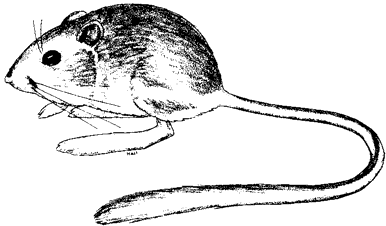
Narrow-faced Kangaroo Rat
Distribution, Abundance, and Seasonality
Common, permanent resident of chaparral and foothill woodland habitats in the mountain ranges of the central coast. There are 3 disjunct populations. One population occurs in the Santa Cruz Mts., another lives on Mt. Hamilton at the northern end of the Gabilan Range, and the third population occurs in the Santa Lucia Mt. region (Grinnell 1922). This kangaroo rat is found from sea level to 1799 m (0-5900 ft) elevation.

Range Map
Specific Habitat Requirements
Feeding: Narrow-faced kangaroo rats primarily eat seeds of annual forbs and grasses. They also eat some green vegetation. Hawbecker (1940) found that seeds of telegraph weed and ripgut brome were the most abundant species found in cheek pouches and caches. Mature seeds usually are gathered after they fall to the ground. They are carried in cheek pouches, and then transferred to surface or underground food caches (Hawbecker 1940).
Cover: These kangaroo rats use burrows in well-drained loam, or sandy loam, for cover (Hawbecker 1940). Their burrow systems are relatively simple, compared to those of other species of Dipodomys. Hawbecker (1940) excavated 15 burrows and found that the chambers were from 5.1 to 50.8 cm (2-20 in) below the ground surface. Supplementary chambers usually were located near the main one, apparently for escape.
Reproduction: Nest cavities are located underground, usually below the main burrow chamber. These nest cavities may be partially filled with chaff from forb and grass fruits.
Water: Water apparently is not required although this species is less efficient at conserving body water than are kangaroo rats from more arid climates (Church 1969).
Pattern: Suitable habitat is characterized by open areas surrounded by chaparral, foothill woodlands, and brush/herbaceous edges. Undisturbed, well-drained loam and sandy loam soils are required for burrowing.
Species Life History
Activity Patterns: Yearlong nocturnal activity.
Seasonal Movements / Migration: Non-migratory.
Home Range: Home ranges averaged about 0.25 ha (0.61 ac) (N = 4) (Bradford 1976).
Territory: Territory and home range probably are the same.
Reproduction: No data found.
Niche: D. venustus is closely related to D. agilis. Unlike pocket gophers and ground squirrels, D. venustus often is eliminated from farmed lands, because its relatively shallow burrows are destroyed by cultivation (Hawbecker 1940). Coyotes, bobcats, long-tailed weasels, badgers, feral and domestic cats, great horned owls, barn owls, and various snakes prey on narrow-faced kangaroo rats. Active burrows often used by dung beetles, crickets, and toads (Hawbecker 1940).
Sources & References
California Department of Fish and Game, 1999.
California's Wildlife, Sacramento, CA.
Written by: G. Ahlborn, reviewed by: M. White, edited by: G. Ahlborn, M. White
Bradford, D. F. 1976. Space utilization by rodents in Adenostoma chaparral. J. Mammal. 57:576-579.
Church, R. L. 1969. Evaporative water loss and gross effects of water privation in the kangaroo rat, Dipodomys venustus. J. Mammal. 50:514-523.
Grinnell, J. 1922. A geographical study of the kangaroo rats of California. Univ. Calif. Publ. Zool. 24:1-124. Hawbecker, A. C. 1940. The burrowing and feeding habits of Dipodomys venustus. J. Mammal. 21:388-396. Stock, A. D. 1974. Chromosome evolution in the genus Dipodomys and its taxonomic and phylogenetic implications. J. Mammal. 55:505-527.
California Animal Facts | California's Wildlife